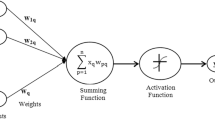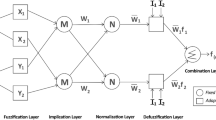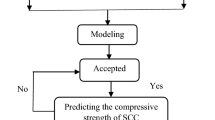Abstract
Pervious concrete is a kind of concrete used for storm-water management due to its high porosity and permeability. However, its’ flexural strength as the most desirable mechanical properties was predicted in this study. The paper aims to demonstrate three soft-computing models, i.e., artificial neural network (ANN), support vector machine (SVM), and adaptive neuro-fuzzy inference system (ANFIS) were applied for the prediction of flexural strength (\(\sigma f)\) of pervious Concrete (PC) incorporated with calcium carbide waste (CCW) and rice husk ash (RHA) as supplementary cementation materials. The models were trained on the experimental data obtained by replacing cement content from 0 to 10% RHA and 0 to 20% CCW in the PC at 3-, 7-, and 28-days curing age. The results indicated that three AI-based models ANN, SVM, and ANFIS have predicted the flexural strength with high accuracy in both the testing and training stages, following the performance evaluation involving; Nash–Sutcliffe efficiency (NSE), correlation coefficient (CC), mean square error (MSE), and root mean square error (RMSE). All the input variables contribute to the accuracy of the model. The ANFIS-M5 (NSE = 0.9997 and RMSE = 0.0044 in testing phase) proved merit despite the acceptable accuracy obtained in the ANN model. The hybrid ANFIS predicts the flexural strength of hybridized pervious concrete with the highest accuracy compared to the other two soft-computing models.











Similar content being viewed by others
References
Abba SI, Abdulkadir RA, Gaya MS, Saleh MA, Esmaili P, Jibril MB (2019) Neuro-fuzzy ensemble techniques for the prediction of turbidity in water treatment plant. In: 2019 2nd international conference of the IEEE Nigeria computer Chapter, NigeriaComputConf 2019, 1–6. https://doi.org/10.1109/NigeriaComputConf45974.2019.8949629
Abdullahi G, IŞIK S, ABBA SI, MERİÇLİ F (2020) Artificial intelligence–based models for the qualitative and quantitative prediction of a phytochemical compound using HPLC method. Turkish J Chem 44(5):1339–1351. https://doi.org/10.3906/kim-2003-6
ACI 552R-10 (2010) Report on pervious concrete, American concrete institute. American Concrete Institute, Farmington Hills, Mishigan, 38
Alas M, Ismael S, Ali A, Ph D, Asce AM, Abdulhadi Y, Abba SI, Ph D (2020) Experimental evaluation and modeling of polymer nanocomposite modified asphalt binder using ANN and ANFIS. J Mater Civ Eng 32(10):1–11. https://doi.org/10.1061/(ASCE)MT.1943-5533.0003404
Albuthbahak OM, Alkhudery HH (2018) Artificial neural network model for flexural design of concrete hydraulic structures. Int J Civil Eng Technol 9(2):265–274
Alexandre Bogas J, Gomes A (2013) A simple mix design method for structural lightweight aggregate concrete. Mater Struct 46(11):1919–1932
Alkroosh IS, Sarker PK (2019) Prediction of the compressive strength of fly ash geopolymer concrete using gene expression programming. Comput Concr 24(4):295–302
Arjenaki MO, Sanayei HRZ (2020) Numerical investigation of energy dissipation rate in stepped spillways with lateral slopes using experimental model development approach. Model Earth Syst Environ 6(2):605–616
Arjenaki MO, Sanayei HRZ, Heidarzadeh H, Mahabadi NA (2021) Modeling and investigating the effect of the LID methods on collection network of urban runoff using the SWMM model (case study: Shahrekord City). Model Earth Syst Environ 7(1):1–16. https://doi.org/10.1007/s40808-020-00870-2
Asteris, P. G., & Mokos, V. G. (2020). Concrete compressive strength using artificial neural networks. Neural Comput Appl 32(15):11807–11826. https://doi.org/10.1007/s00521-019-04663-2
ASTM C127-15 (2015) Standard test method for relative density (specific gravity) and absorption of coarse aggregate. ASTM International, West Conshohocken, PA
ASTM C150/C150M-20 (2015) Standard specification for portland cement. ASTM international, West Conshohocken
ASTM C188-17 (2017) Standard test method for density of hydraulic cement. ASTM international, West Conshohocken, PA
Azimi-Pour M, Eskandari-Naddaf H, Pakzad A (2020) Linear and non-linear SVM prediction for fresh properties and compressive strength of high volume fly ash self-compacting concrete. Constr Build Mater 230:117021
Barzegar R, Sattarpour M, Reza M (2016) Comparative evaluation of artificial intelligence models for prediction of uniaxial compressive strength of travertine rocks, Case study: Azarshahr area, NW Iran. Model Earth Syst Environ. https://doi.org/10.1007/s40808-016-0132-8
Benghazi Z, Zeghichi L, Djellali A, Hafdallah A (2020) Predictive modeling and multi-response optimization of physical and mechanical properties of SCC based on sand’s particle size distribution. Arab J Sci Eng 45(10):8503–8514
Bingöl AF, Tortum A, Gül R (2013) Neural networks analysis of compressive strength of lightweight concrete after high temperatures. Mater Design (1980-2015) 52:258–264
BS EN 12390-5 (2000) Testing hardened concrete. Flexural strength of test specimens. British standard Institute, USA
Correia SL, Partala T, Loch FC, Segadães AM (2010) Factorial design used to model the compressive strength of mortars containing recycled rubber. Compos Struct 92(9):2047–2051
Deshpande N, Londhe S, Kulkarni S (2014) Modeling compressive strength of recycled aggregate concrete by artificial neural network, model tree and non-linear regression. Int J Sustain Built Environ 3(2):187–198
Elkiran G, Nourani V, Abba SI, Abdullahi J (2018) Artificial intelligence-based approaches for multi-station modelling of dissolve oxygen in river. Glob J Environ Sci Manage 4(4):439–450. https://doi.org/10.22034/gjesm.2018.04.005
Ghorbani MA, Deo RC, Yaseen ZM, Kashani MH, Mohammadi B (2018) Pan evaporation prediction using a hybrid multilayer perceptron-firefly algorithm (MLP-FFA) model: case study in North Iran. Theoret Appl Climatol 133(3–4):1119–1131
Granata F, Papirio S, Esposito G, Gargano R, de Marinis G (2017) Machine learning algorithms for the forecasting of wastewater quality indicators. Water (switzerland) 9(2):1–12
Hadi SJ, Abba SI, Sammen SSH, Salih SQ, Al-ansari N, Yaseen ZM (2019) Non-linear input variable selection approach integrated with non-tuned data intelligence model for streamflow pattern simulation. 1–16
Handhal AM (2016) Prediction of reservoir permeability from porosity measurements for the upper sandstone member of Zubair Formation in Super- Giant South Rumila oil field, southern Iraq, using M5P decision tress and adaptive neuro-fuzzy inference system ( ANFIS ): a com. Model Earth Syst Environ 2:1–8
Jimma BE, Rangaraju PR (2015) Chemical admixtures dose optimization in pervious concrete paste selection—A statistical approach. Constr Build Mater 101:1047–1058
Kooshkaki A, Eskandari-naddaf H (2019) Effect of porosity on predicting compressive and flexural strength of cement mortar containing micro and nano-silica by multi-objective ANN modeling. Constr Build Mater 212:176–191
Kumar NSH, Choudhary RP, Murthy CSN (2019) Evolution of the probability distribution function of shovel–dumper combination in open cast limestone mine using RWB and ANN: a case study. Model Earth Syst Environ 5(4):1607–1613
Laqui W, Zubieta R, Rau P, Mejía A, Lavado W, Ingol E (2019) Can artificial neural networks estimate potential evapotranspiration in Peruvian highlands? Model Earth Syst Environ 5(4):1911–1924. https://doi.org/10.1007/s40808-019-00647-2
Madandoust R, Bungey JH, Ghavidel R (2012) Prediction of the concrete compressive strength by means of core testing using GMDH-type neural network and ANFIS models. Comput Mater Sci 51(1):261–272
Maguesvari MU, Narasimha VL (2013) Studies on characterization of pervious concrete for pavement applications. Procedia Soc Behav Sci 104:198–207
Soleimani M, Behzadian K, Ardeshir A (2016) Evaluation of strategies for modifying urban storm water drainage system using risk-based criteria. J Water Wastewater 26(6):16–29
Makaratat N, Jaturapitakkul C, Namarak C, Sata V (2011) Effects of binder and CaCl2 contents on the strength of calcium carbide residue-fly ash concrete. Cement Concr Compos 33(3):436–443
Mansour A, Amir B, Haghiabi H, Shamsi Z, Parsaie A (2020) Predictive modeling the discharge of urban wastewater using artificial intelligent models (case study : Kerman city). Modeling Earth Systems and Environment. https://doi.org/10.1007/s40808-020-00900-z
Mahmodian AR, Rajabi A, Izadbakhsh MA, Shabanlou S (2019) Evaluation of side orifices shape factor using the novel approach self-adaptive extreme learning machine. Modeling Earth Systems and Environment 5(3):925–935. https://doi.org/10.1007/s40808-019-00579-x
Momeni E, Dowlatshahi MB, Omidinasab F, Maizir H, Armaghani DJ (2020) Gaussian process regression technique to estimate the pile bearing capacity. Arab J Sci Eng 45(10):8255–8267
Nash JE, Sutcliffe JV (1970) River flow forecasting through conceptual models part I—A discussion of principles. J Hydrol 10(3):282–290
Nofal NO, Hamdy GA, Ibrahim TA, Saad SG (2017) Enhancement of properties of sustainable porous concrete through mix design. 67(7): 203–220
Omidi M, Hamed A, Zarif R, Heisam S, Niloofar H, Mahabadi A (2020) Modeling and investigating the effect of the LID methods on collection network of urban runoff using the SWMM model (case study : Shahrekord City). Modeling Earth Systems and Environment. 0123456789
Park J, Yoo Y, Park Y, Yoon H, Kim J, Park Y, Kyoung, Jeon JH, Lim J (2008) Analysis of Runoff Reduction with LID Adoption using the SWMM. 24(6): 805–815
Parsaie A, Allah H, Shadi Y (2015) Predictive modeling of discharge in compound open channel by support vector machine technique. Model Earth Syst Environ. https://doi.org/10.1007/s40808-015-0002-9
Pieralisi R, Cavalaro SHP, Aguado A (2021) Discrete element modelling of mechanical behaviour of pervious concrete. Cem Concr Compos 119:104005
Rahman MA, Imteaz MA, Arulrajah A, Piratheepan J, Disfani MM (2015) Recycled construction and demolition materials in permeable pavement systems: geotechnical and hydraulic characteristics. J Clean Prod 90:183–194
Ramana KVS, Anita T, Mandal S, Kaliappan S, Shaikh H, Sivaprasad PV, Dayal RK, Khatak HS (2009) Effect of different environmental parameters on pitting behavior of AISI type 316L stainless steel: experimental studies and neural network modeling. Mater Des 30(9):3770–3775
Sadrmomtazi A, Sobhani J, Mirgozar MA (2013) Modeling compressive strength of EPS lightweight concrete using regression, neural network and ANFIS. Constr Build Mater 42:205–216
Salihi AMAL (2017) Impact of precipitation on aerosols index over selected stations in Iraq using remote sensing technique. Model Earth Syst Environ 3(3):861–871. https://doi.org/10.1007/s40808-017-0315-y
Shariati M, Mafipour MS, Mehrabi P, Bahadori A, Zandi Y, Salih MN, Nguyen H, Dou J, Song X, Poi-Ngian S (2019) Application of a hybrid artificial neural network-particle swarm optimization (ANN-PSO) model in behavior prediction of channel shear connectors embedded in normal and high-strength concrete. Appl Sci 9(24):534
Shariati M, Mafipour MS, Mehrabi P, Shariati A, Toghroli A, Trung NT, Salih MNA (2020) A novel approach to predict shear strength of tilted angle connectors using artificial intelligence techniques. Eng Comput. https://doi.org/10.1007/s00366-019-00930-x
Sharma N, Zakaullah M, Tiwari H, Kumar D (2015) Runoff and sediment yield modeling using ANN and support vector machines: a case study from Nepal watershed. Model Earth Syst Environ 1(3):23
Słoński M (2010) A comparison of model selection methods for compressive strength prediction of high-performance concrete using neural networks. Comput Struct 88(21–22):1248–1253
Solgi A, Zarei H, Nourani V, Bahmani R (2017) A new approach to flow simulation using hybrid models. Appl Water Sci 7(online):16
Sun J, Zhang J, Gu Y, Huang Y, Sun Y, Ma G (2019) Prediction of permeability and unconfined compressive strength of pervious concrete using evolved support vector regression. Constr Build Mater 207:440–449
Takagi T, Sugeno M (1974) Application of Fuzzy algorithm for control of simple dynamic plant. IEEE Proc 12:1585–1588
Taylor KE (2001) Summarizing multiple aspects of model performance in a single diagram. J Geophys Res 106(D7):7183–7192
Thankakan R, Samuel Nadar ER (2021) ANFIS-based MPPT controller of the thermoelectric energy harvesting system for DC micro-grid applications. Arab J Sci Eng 46(2):1137–1154
Usman AG, Işik S, Abba SI (2020) A novel multi-model data-driven ensemble technique for the prediction of retention factor in HPLC method development. Chromatographia 83(8):933–945. https://doi.org/10.1007/s10337-020-03912-0
Vapnik V (1995) The nature of statistical learning theory, p 188. https://doi.org/10.1007/978-1-4757-2440-0
Wulliman J, Thomas P (2005) Learning from nature: reducing urban stormwater impacts lake line magazine. Urban Drainage and Flood Control District, Denver
Yazdani M, Kabirifar K, Frimpong BE, Shariati M, Mirmozaffari M, Boskabadi A (2021) Improving construction and demolition waste collection service in an urban area using a simheuristic approach: a case study in Sydney Australia. J Clean Produc 280:124138
Zhenyan L, Hamid S, Zainah I, Mahdi S, Zamin J, Karzan W, Thai PB, Tonnizam ME, Majid K (2019) Computational and experimental analysis of beam to column joints reinforced with CFRP plates. Steel Compos Struct 30(3):271–280
Acknowledgements
The authors acknowledge the Department of Civil Engineering Laboratory, Bayero University Kano-Nigeria, for their support throughout this study.
Author information
Authors and Affiliations
Corresponding author
Ethics declarations
Conflict of interest
The authors declared no conflict of interest in the manuscript.
Additional information
Publisher's Note
Springer Nature remains neutral with regard to jurisdictional claims in published maps and institutional affiliations.
Rights and permissions
About this article
Cite this article
Malami, S.I., Musa, A.A., Haruna, S.I. et al. Implementation of soft-computing models for prediction of flexural strength of pervious concrete hybridized with rice husk ash and calcium carbide waste. Model. Earth Syst. Environ. 8, 1933–1947 (2022). https://doi.org/10.1007/s40808-021-01195-4
Received:
Accepted:
Published:
Issue Date:
DOI: https://doi.org/10.1007/s40808-021-01195-4




